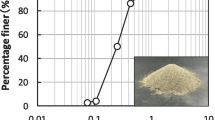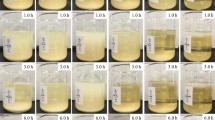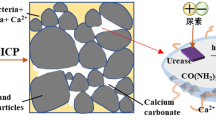Abstract
Purpose
Microbially induced calcite precipitation (MICP) has been shown to mitigate sand erosion; however, only few studies have used it on loess soils.
Materials and methods
This study used MICP to investigate the effects of this technology on the improvement of the surface erosion resistance of loess slopes. Polyvinyl acetate (PVAc) was added to the cementation solution to further increase slope stability.
Results and discussion
The obtained results showed that MICP treatment resulted in an improvement of erosion resistance and treatment with 3 L/m2 bacterial suspension of Sporosarcina pasteuriiand 3 L/m2 cementation solution (0.75 M of Ca(Ac)2 and 0.75 M of urea) achieved the best erosion control and the highest surface strength. However, in rainfall simulation experiment, the eroded loss weight of loess soil in MICP-treated slopes still remained large. After adding PVAc to the cementation solution, the stability of the loess slope increased significantly and resulted in less soil loss after rainfall erosion and an increase in surface strength. With 60 g/L PVAc, the surface strength of the slope decreased by about 130 kPa compared with 40 g/L PVAc because of the thinner depth of cementation. The high erosion resistance of the slope with added PVAc could be attributed to (1) the network structure of PVAc to affix the calcium carbonate precipitation and (2) the stronger resistance to tension or shear force from PVAc. These results demonstrated that MICP-PVAc treatment significantly mitigated surface erosion of loess slopes, which presents promising potential for application in the field.











Similar content being viewed by others
Data availability
All data, models, or codes that support the findings of this study are available from the corresponding author upon reasonable request.
References
Ahmed M, Abd-Elhamid M, Sarhan A, Hassan A (2017) Characteristic and thermal stimulated depolarization current of poly (vinyl chloride-co-vinyl acetate-co-2-hydroxy propyl acrylate) Znonanocomposite. Glob J Phys 5:585–594
Al Qabany A, Soga K (2013) Effect of chemical treatment used in MICP on engineering properties of cemented soils. Géotechnique 63(4):331–339
Al Qabany A, Soga K, Santamarina C (2012) Factors affecting efficiency of microbially induced calcite precipitation. J Geotech Geoenviron Eng 138(8):992–1001
Amin M, Zomorodian S, Kelly B (2017) Reducing the hydraulic erosion of sand using microbial-induced carbonate precipitation. Proc Inst Civ Eng Ground Improv 170(2):112–122
Bu F, Liu J, Bai Y, Prasanna Kanungo D, Song Z, Kong F, Pan C (2019) Effects of the preparation conditions and reinforcement mechanism of polyvinyl acetate soil stabilizer. Polymers 11(3):506
Chang I, Prasidhi A, Im J, Shin H, Cho G (2015) Soil treatment using microbial biopolymers for anti-desertification purposes. Geoderma 253–254:39–47
DeJong J, Fritzges M, Nüsslein K (2006) Microbially induced cementation to control sand response to undrained shear. J Geotech Geoenviron Eng 132(11):1381–1392
DeJong J, Mortensen B, Martinez B, Nelson D (2010) Bio-mediated soil improvement. Ecol Eng 36(2):197–210
Delage P, Marcial D, Cui Y, Ruiz X (2006) Ageing effects in a compacted bentonite: a microstructure approach. Géotechnique 56(5):291–304
Derbyshire E, Meng XM, Dijkstra T (2000) Landslides in the thick loess terrain of North-West China. John Wiley and Sons Ltd, London
Dossi M, Liang K, Hutchinson R, Moscatelli D (2010) Investigation of free-radical copolymerization propagation kinetics of vinyl acetate and methyl methacrylate. J Phys Chem B 114:4213–4222
Gao H, Li Z, Jia L, Li P, Xu G, Ren Z, Pang G (2016) Capacity of soil loss control in the loess plateau based on soil erosion control degree. J Geogr Sci 26(4):457–472
Gao Y, Tang X, Chu J, He J (2019) Microbially induced calcite precipitation for seepage control in sandy soil. Geomicrobiol J 36(4):366–375
Ghasemzadeh H, Mehrpajouh A, Pishvaei M, Mirzababaei M (2020) Effects of curing method and glass transition temperature on the unconfined compressive strength of acrylic liquid polymer–stabilized kaolinite. J Mater Civ Eng 32(8):04020212
Ghasemzadeh H, Modiri F (2020) Application of novel Persian gum hydrocolloid in soil stabilization. Carbohyd Polym 246:116639
Gordon P, Bierwagen J, Preston M (2019) Stevens Ferdinand Rodriguez George B. Kauffman Alan N. Gent. Major industrial polymers. Encyclopædia Britannica, inc.
Huo A, Wang X, Liang Y, Jiang C, Zheng X (2019) Integrated numerical model for irrigated area water resources management. J Water Clim Change, jwc2019042
Huo A, Yang L, Peng J, Cheng Y, Jiang C (2020) Spatial characteristics of the rainfall induced landslides in the Chinese Loess Plateau. Hum Ecol Risk Assess Int J 2020:1–16
Jazi M, SA A, Haddadi S, Ghaderi S, Azamian F (2019) In situ emulsion polymerization and characterization of PVAc nanocomposites including colloidal silica nanoparticles for wood specimens bonding. J Appl Polym Science
Jiang N, Tang C, Yin L, Xie Y, Shi B (2019) Applicability of microbial calcification method for sandy-slope surface erosion control. J Mater Civ Eng 31(11):04019250
Juang C, Dijkstra T, Wasowski J, Meng X (2019) Loess geohazards research in China: advances and challenges for mega engineering projects. Eng Geol 251:1–10
Khan M, Amarakoon G, Shimazaki S, Kawasaki S (2015) Coral sand solidification test based on microbially induced carbonate precipitation using ureolytic bacteria. Mater Trans 56(10):1725–1732
Leng Y, Peng J, Wang Q, Meng Z, Huang W (2018) A fluidized landslide occurred in the Loess Plateau: a study on loess landslide in South Jingyang Tableland. Eng Geol 236:129–136
Luo H, Wu FQ, Chang JY, Xu JB (2018) Microstructural constraints on geotechnical properties of Malan Loess: a case study from Zhaojiaan landslide in Shaanxi province. China Eng Geol 236:60–69
Mahawish A, Bouazza A, Gates W (2018) Effect of particle size distribution on the bio-cementation of coarse aggregates. Acta Geotech 13(4):1019–1025
Miao L, Wu L, Sun X, Li X, Zhang J (2019) Method of solidifying desert sands with enzyme‐catalysed mineralization. Land Degrad Develop
Nafisi A, Mocelin D, Montoya B, Underwood S (2020a) Tensile strength of sands treated with microbially induced carbonate precipitation. Can Geotech J 57(10):1611–1616
Nafisi A, Montoya B, Evans T (2020b) Shear strength envelopes of biocemented sands with varying particle size and cementation level. Journal of Geotechnical and Geoenvironmental Engineering 146(3):04020002
Peng J, Wang G, Wang Q, Zhang F (2017) Shear wave velocity imaging of landslide debris deposited on an erodible bed and possible movement mechanism for a loess landslide in Jingyang, Xi’an, China. Landslides 14:1503–1512
Qi X, Xu Q, Liu F (2018) Analysis of retrogressive loess flow slides in Heifangtai. China Eng Geol 236:119–128
Rosdi M, Ariffin A (2016) Evaluation of flow ability response in EVA emulsion preparation with different vinyl acetate percentage by intrinsic viscosity measurement. Procedia Chem 19:455–461
Saffari R, Nikooee E, Habibagahi G, Van Genuchten M (2019) Effects of biological stabilization on the water retention properties of unsaturated soils. J Geotech Geoenviron Eng 145(7), 04019028.1–04019028.12
Salifu E, MacLachlan E, Iyer K, Knapp C, Tarantino A (2016) Application of microbially induced calcite precipitation in erosion mitigation and stabilisation of sandy soil foreshore slopes: a preliminary investigation. Eng Geol 201: 96–105
Seagren E, Aydilek A (2010) Biomediated geomechanical processes. In Environmental biology, 319–349. Hoboken, NJ: Wiley
Shanahan C, Montoya B (2014) Strengthening coastal sand dunes using microbial-induced calcite precipitation. In Proc. GeoCongress 2014, GSP 234, edited by M. Abu-Farsakh, X. Yu, and L. R. Hoyos. Reston, VA: ASCE
Shields J (1984) Adhesives handbook, 3rd edn. Butterworths Heinemann, London
Smalley I (1995) Making the material: the formation of silt sized primary mineral particles for loess deposits. Quat Sci Rev 14(7–8):645–651
Soldo A, Miletić M, Auad M (2020) Biopolymers as a sustainable solution for the enhancement of soil mechanical properties. Sci Rep 10(1):1–13
Stocks-Fischer S, Galinat JK, Bang SS (1999) Microbiological precipitation of CaCO3. Soil Biol Biochem 31(11):1563–1571
Sun X, Miao L, Tong T, Wang C (2018) Improvement of microbial-induced calcium carbonate precipitation technology for sand solidification. J Mater Civ Eng 30(11):04018301
Sun X, Miao L, Tong T, Wang C (2019a) Study of the effect of temperature on microbially induced carbonate precipitation. Acta Geotech 14(3):627–638
Sun X, Miao L, Wu L, Chen R (2019b) Improvement of bio-cementation at low temperature based on Bacillus megaterium. Appl Microbiol Biotechnol 103(17):7191–7202
Sun X, Miao L, Chen R (2020a) The application of bio-cementation for improvement in collapsibility of loess. Internatl J Environ Sci Technol (5)
Sun X, Miao L, Yuan J, Wang H, Wu L (2020b) Application of enzymatic calcification for dust control and rainfall erosion resistance improvement. Sci Total Environ 143468.
Sun X, Miao L, Wu L, Wang H (2021a) Theoretical quantification for cracks repair based on microbially induced carbonate precipitation (micp) method. Cement Concrete Compos (1):103950
Sun X, Miao L, Wang H, Chen R, Guo X (2021b) Improvement of characteristics and freeze-thaw durability of solidified loess based on microbially induced carbonate precipitation. Bull Eng Geol Environ
Sun X, Miao L, Wang H, Yuan J, Fan G (2021c) Enhanced rainfall erosion durability of enzymatically induced carbonate precipitation for dust control. Sci Total Environ 148369
Tittelboom K, Belie N, Muynck W (2010) Use of bacteria to repair cracks in concrete. Cem Concr Res 40(1):157–166
Tran A, Chang I, Cho G (2019) Soil water retention and vegetation survivability improvement using microbial biopolymers in drylands. Geomech Eng 17(5):475–483
Ulusay R, Erguler Z (2012) Needle penetration test: evaluation of its performance and possible uses in predicting strength of weak and soft rocks. Eng Geol 149:47–56
Van Asch T, Buma J, Van Beek L (1999) A view on some hydrological triggering systems in landslides. Geomorphology 30:25–32
Wang H, Wang Q, Shao M (2006) Laboratory experiments of soil nutrient transfer in the loess slope with surface runoff during simulated rainfall. Trans Chin Soc Agric Eng 22(6):39–44
Wang X, Tao J, Bao R, Tran T, Tucker-Kulesza S (2018) Surficial soil stabilization against water-induced erosion using polymermodified microbially induced carbonate precipitation. J Mater Civ Eng 30(10):04018267
Whiffin V (2004) Microbial CaCO3 precipitation for the production of biocement. Murdoch University, Perth, Australia
Wu L, Liu X, Ma X (2016) Spatiotemporal distribution of rainfall erosivity in the Yanhe River watershed of hilly and gully region. Chinese Loess Plateau Environ Earth Sci 75(4):315
Xu R, Li X, Yang W, Jiang C, Rabiei M (2019) Use of local plants for ecological restoration and slope stability: a possible application in Yan’an, Loess Plateau, China. Geomat Nat Haz Risk 10(1):2106–2128
Zhan Q, Qian C, Yi H (2016) Microbial-induced mineralization and cementation of fugitive dust and engineering application. Constr Build Mater 121:437–444
Zhang Y, Pang B, Yang S, Fang W, Yang S, Yuan T, Sun R (2018) Improvement in wood bonding strength of poly (vinyl acetate-butyl acrylate) emulsion by controlling the amount of redox initiator. Materials 11(1):89
Zhang Y, Zhu Q (2006) Analysis on eroded rainfall characteristics of Loess Plateau. Res Environ Arid Land 06:99–103
Zhao Z, Hamdan N, Shen L, Nan H, Almajed A, Kavazanjian E, He X (2016) Biomimetic hydrogel composites for soil stabilization and contaminant mitigation. Environ Sci Technol 50(22):12401–12410
Zhuang J, Peng J, Wang G, Iqbal J, Wang Y, Li W, Xu Q, Zhu X (2017) Prediction of rainfall-induced shallow landslides in the Loess Plateau, Yan’an, China, using the TRIGRS model. Earth Surf Process Landf 42(6):915–927
Acknowledgements
The authors thank the valuable comments from the reviewers. This study was funded by National Natural Science Foundation of China (grant number 51578147), Fundamental Research Funds for the Central Universities (grant number 2242020R20025), Science and Technology Department of Ningxia (grant number 2020BFG02014), and Transportation Department of Ningxia (grant number 202000173).
Author information
Authors and Affiliations
Corresponding author
Ethics declarations
Ethics approval
This article does not contain any studies with human participants performed by any of the authors.
Conflict of interest
The authors declare no competing interests.
Additional information
Responsible editor: Pariente Sarah
Publisher's Note
Springer Nature remains neutral with regard to jurisdictional claims in published maps and institutional affiliations.
Supplementary information
Below is the link to the electronic supplementary material.
Rights and permissions
About this article
Cite this article
Sun, X., Miao, L., Wang, H. et al. Bio-cementation for the mitigation of surface erosion in loess slopes based on simulation experiment. J Soils Sediments 22, 1804–1818 (2022). https://doi.org/10.1007/s11368-022-03190-3
Received:
Accepted:
Published:
Issue Date:
DOI: https://doi.org/10.1007/s11368-022-03190-3




